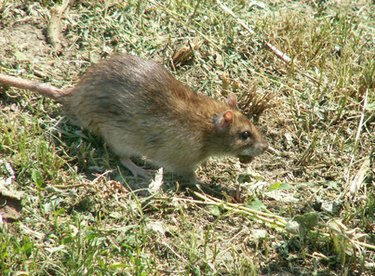
Bromadiolone is a type of rat poison that became popular due to its unique benefits several decades ago. It is an anticoagulant, a popular type of poison used for the control of both rat and mice populations. Though there are several types of anticoagulants available as rat poison, some populations developed a resistance to these. As a result, new anticoagulants were produced, among them bromadiolone. It has proven effective against these resistant rat populations, according to an article written in 1978 by Adrian P. Meehan, Chief Biologist, Rentokil Limited.
How It Works
Video of the Day
Bromadiolone interferes with vitamin K activity, as explained in Meehan's article. This is what all classical indirect anticoagulants do, but the potency of bromadiolone is 10 times that of other anticoagulants. Eventually, bromadiolone causes death due to internal bleeding as the rodent's blood can no longer clot and capillaries become damaged, according to the University of California Integrated Pest Management Program. It is mixed with ingredients which attract rodents and encourage ingestion.
Video of the Day
Effectiveness
Bromadiolone is highly effective against rats, according to Cornell University Cooperative Extension. An entire population of rats can be controlled with just one to two feedings, with a mortality rate of 90 percent after just one feeding. Bromadiolone is significantly more effective at controlling both rat and mice populations than similar anticoagulant rat poisons.
Time Frame
Studies reported in the article written by Meehan suggest that even small amounts of this substance can kill rodents efficiently. Time between ingestion and death appeared to be anywhere from one to 14 or more days. Information on the efficacy of this poison in currently available concentrations states that death will occur within 48 hours of consumption for some rodents, or up to five days later for others.
Purchasing Information
Bromadiolone is available in several forms under a number of brand names. It can be bought as concentrate, baits or pellets. Paraffin blocks and tracking powder are also available, according to Cornell University Cooperative Extension. All baits are designed to contain .005 percent of the active ingredient. This rodenticide, in any form, can be used effectively against house mice, roof rats and Norway rats. It can be found under the brand names Bromone, Maki and Supercaid.
Warning
Bromadiolone presents a risk to household pets such as dogs and cats who may eat it. Dogs are more sensitive to this rodenticide than cats, but consumption in either animal can be toxic. Similar dangers exist for small children; any ingestion of bromadiolone by a human should be handled immediately in an emergency medical center. If bromadiolone ingestion is suspected, call 911.